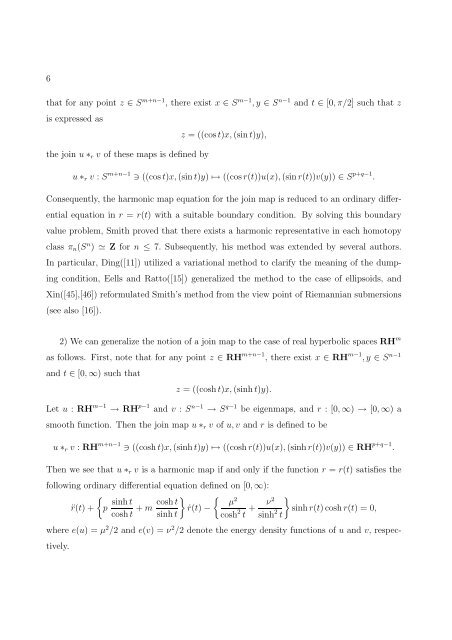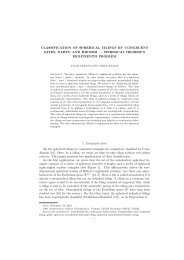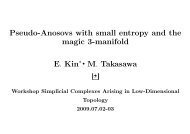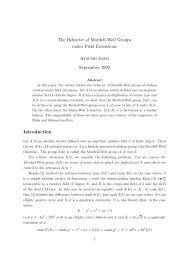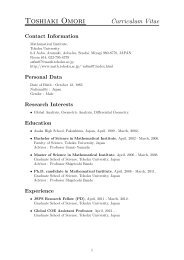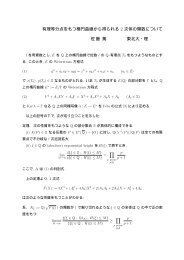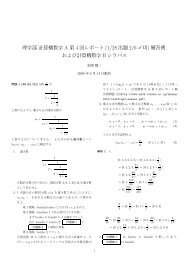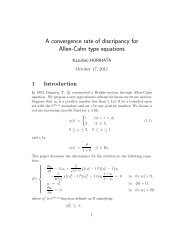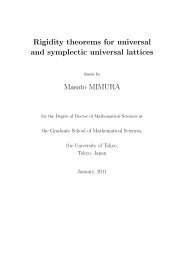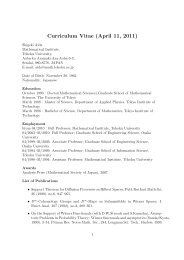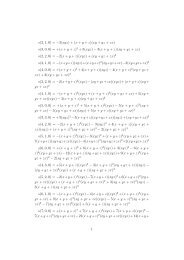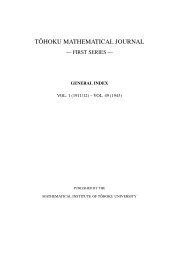Constructions of harmonic maps between Hadamard manifolds
Constructions of harmonic maps between Hadamard manifolds
Constructions of harmonic maps between Hadamard manifolds
Create successful ePaper yourself
Turn your PDF publications into a flip-book with our unique Google optimized e-Paper software.
6<br />
that for any point z ∈ S m+n−1 , there exist x ∈ S m−1 ,y ∈ S n−1 and t ∈ [0,π/2] such that z<br />
is expressed as<br />
z = ((cos t)x, (sin t)y),<br />
the join u ∗ r v <strong>of</strong> these <strong>maps</strong> is defined by<br />
u ∗ r v : S m+n−1 ∋ ((cos t)x, (sin t)y) ↦→ ((cos r(t))u(x), (sin r(t))v(y)) ∈ S p+q−1 .<br />
Consequently, the <strong>harmonic</strong> map equation for the join map is reduced to an ordinary differential<br />
equation in r = r(t) with a suitable boundary condition. By solving this boundary<br />
value problem, Smith proved that there exists a <strong>harmonic</strong> representative in each homotopy<br />
class π n (S n ) ≃ Z for n ≤ 7. Subsequently, his method was extended by several authors.<br />
In particular, Ding([11]) utilized a variational method to clarify the meaning <strong>of</strong> the dumping<br />
condition, Eells and Ratto([15]) generalized the method to the case <strong>of</strong> ellipsoids, and<br />
Xin([45],[46]) reformulated Smith’s method from the view point <strong>of</strong> Riemannian submersions<br />
(see also [16]).<br />
2) We can generalize the notion <strong>of</strong> a join map to the case <strong>of</strong> real hyperbolic spaces RH m<br />
as follows. First, note that for any point z ∈ RH m+n−1 , there exist x ∈ RH m−1 ,y ∈ S n−1<br />
and t ∈ [0, ∞) such that<br />
z = ((cosh t)x, (sinh t)y).<br />
Let u : RH m−1 → RH p−1 and v : S n−1 → S q−1 be eigen<strong>maps</strong>, and r :[0, ∞) → [0, ∞) a<br />
smooth function. Then the join map u ∗ r v <strong>of</strong> u, v and r is defined to be<br />
u ∗ r v : RH m+n−1 ∋ ((cosh t)x, (sinh t)y) ↦→ ((cosh r(t))u(x), (sinh r(t))v(y)) ∈ RH p+q−1 .<br />
Then we see that u ∗ r v is a <strong>harmonic</strong> map if and only if the function r = r(t) satisfies the<br />
following ordinary differential equation defined on [0, ∞):<br />
{<br />
¨r(t)+ p sinh t<br />
cosh t + m cosh t } { }<br />
µ<br />
2<br />
ṙ(t) −<br />
sinh t cosh 2 t +<br />
ν2<br />
sinh 2 sinh r(t) cosh r(t) =0,<br />
t<br />
where e(u) =µ 2 /2 and e(v) =ν 2 /2 denote the energy density functions <strong>of</strong> u and v, respectively.


